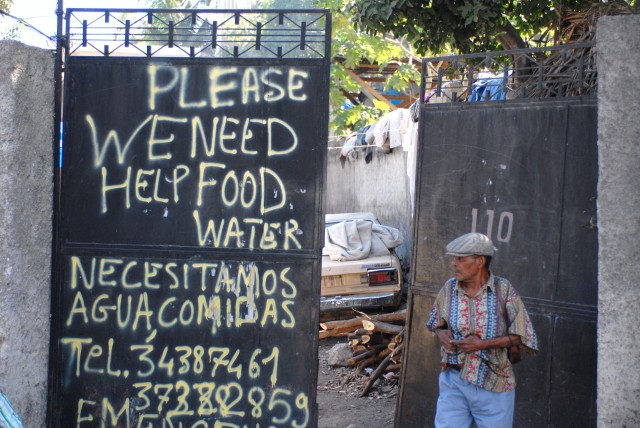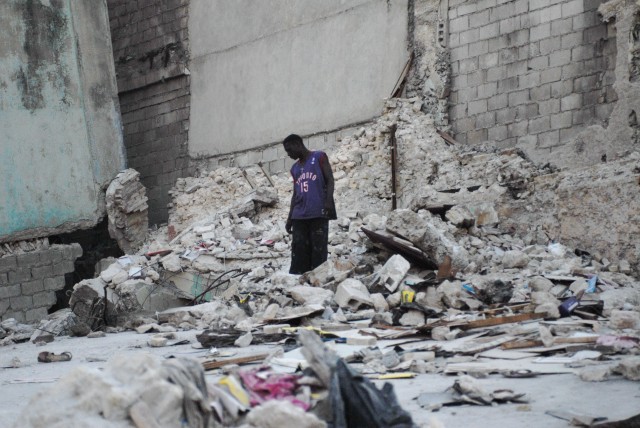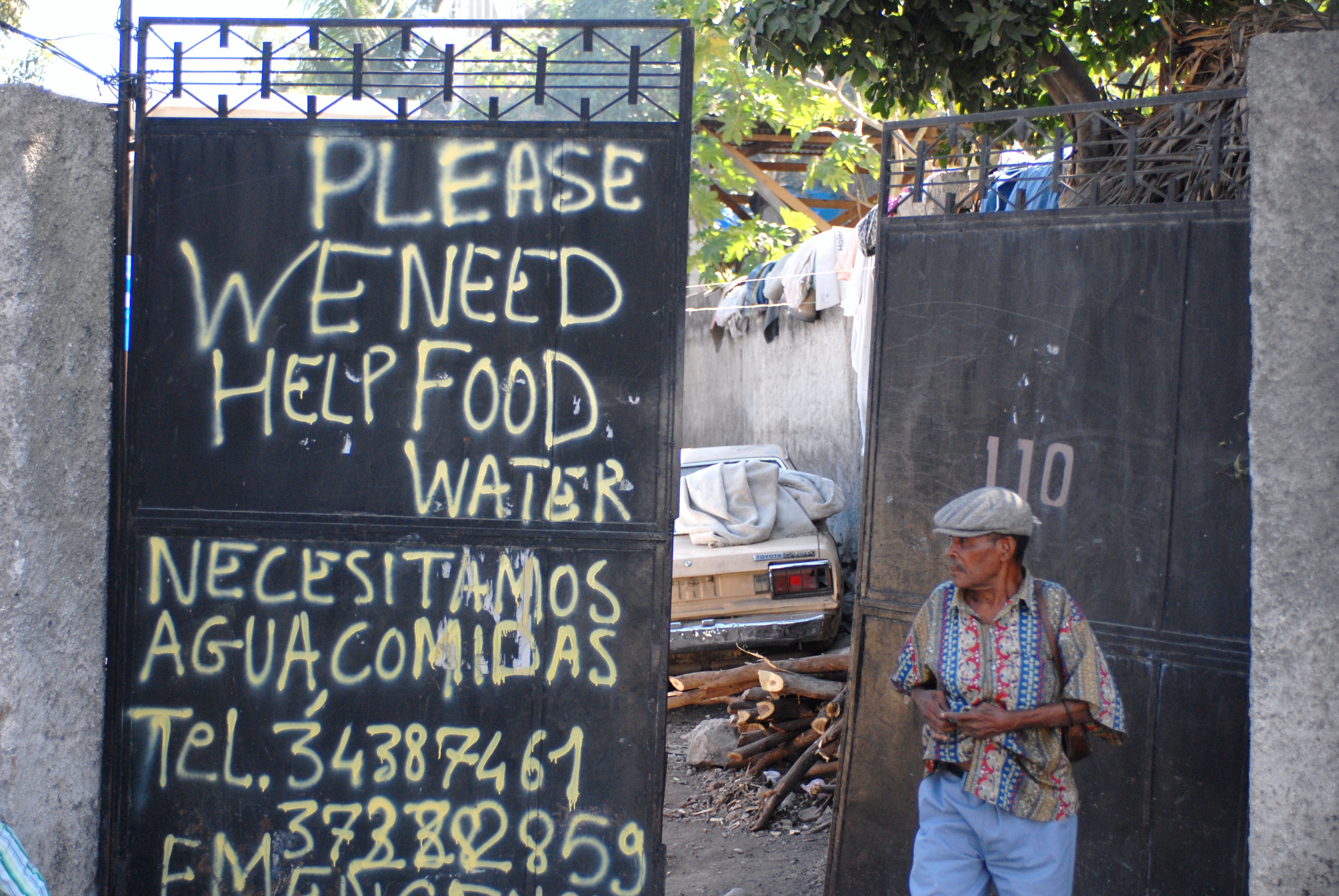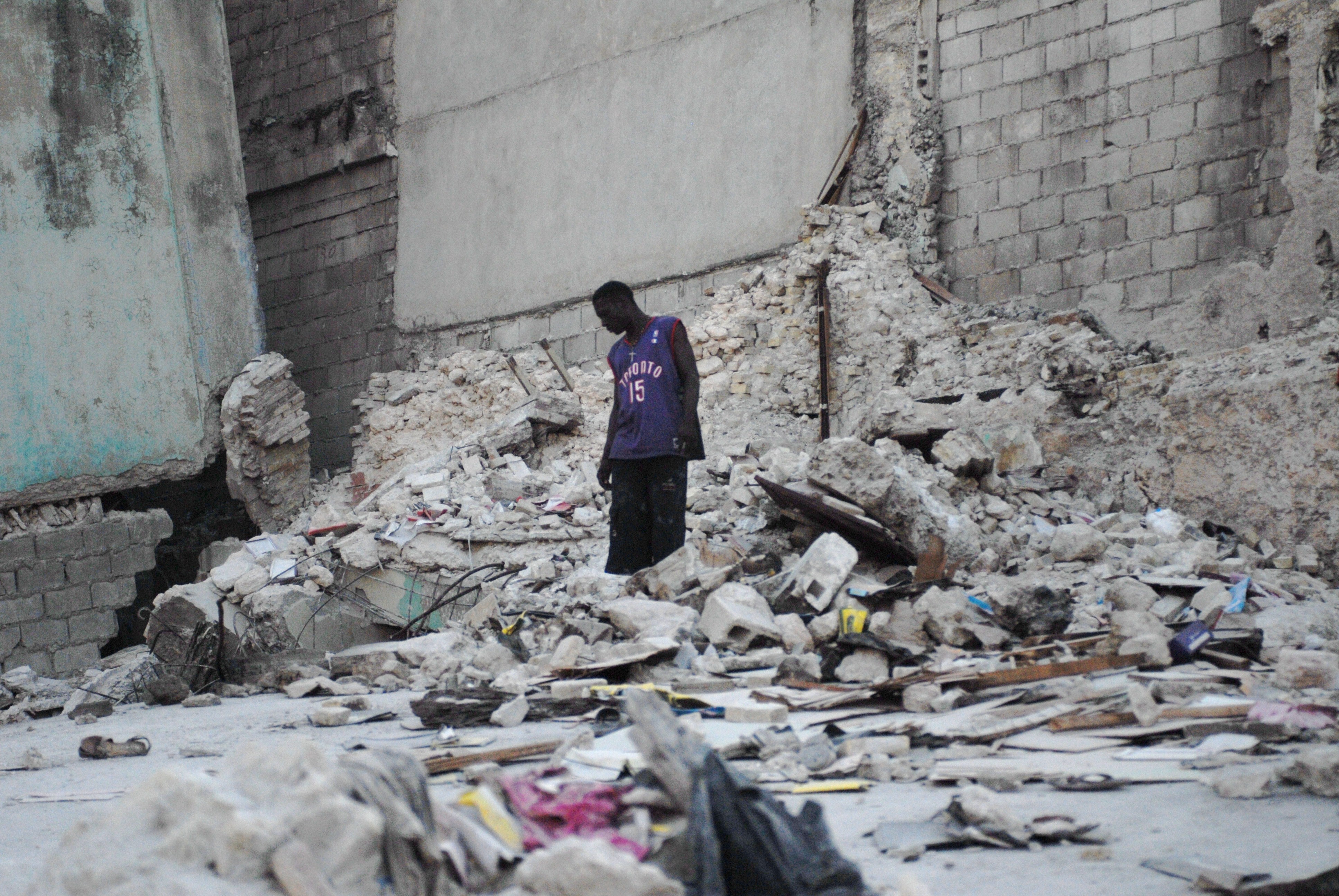(Jan. 24 was the seventh day on the ground in Haiti for Staff Sgt. Roach):
This morning we had a last minute Digital Video and Image Distribution System (a satellite system) shoot with the U.S. Ambassador to Haiti. He spoke with the Today Show at around 7:00 a.m. Eastern time. As soon as he was gone, I took the video camera and the still photo camera for a mission that I thought was going to a food distribution center here in Port-Au-Prince. When I arrived at the Embassy, I found out the photo shoot had been cancelled so I got clearance to go into the city to take still photos and video of some of the neighborhoods that suffered the most damage during the earthquake.
After an exhausting search for the motor pool used by military forces I finally found a Navy Petty Officer in charge of assigning vehicles and drivers for missions in and around the city. I had an excellent Haitian driver named "Junior," before the quake he was a DJ at a local night club that was destroyed. Now he drives U.S. service members to different points around the city.
As we prepared to start our day Junior told me that while his immediate family all survived the earthquake, but he was still missing two aunts, a number of cousins and more friends that he cared to count. I asked Junior to take me to the hardest hit areas. We started our journey through the city by stopping in at the XVIII Airborne Corps Life Support Area to get a few more Soldiers to accompany us for added security. Three Soldiers gladly jumped in our RAV4 and we headed straight to the areas Junior said we should see.
Navigating the traffic in Port-Au-Prince is like watching a well choreographed stunt show at a theme park in the US. Cars pass each other at high rates of speed three and four wide on normal city streets. At anytime you can expect to a car within one-and-half to two inches from your door. At one point a young girl no older than 12, jumped out from between two vehicles and came so close to being hit by our small SUV that everyone in the car let out a gasp. Junior looked over with a worried look on his face and told me that if he had hit her he would have hung himself, when someone says something like that to me I always think they are exaggerating but deep down I believed him.
A few miles from where we started, Junior pointed to a corner market that at one point before it collapsed had apartments over it. I asked him to pull over and we got out and while I shot video and took stills, the Soldiers with me pulled guard and walked with me through the pile of rubble. As I was shooting, a man from the UN walked up to me and showed his ID. He said his boss lived in the apartment building--they were there trying to find his body. That was the first of many buildings we found in the same condition, with the same work going on.
We continued to drive and Junior wanted me to see a large multi-level store with food inside. We crossed the police line and went to see what the recovery effort looked like when so many valuable supplies were at stake. Men loaded food into large trucks while hungry people watched from across the yellow tape. After I had taken my shots we got back in the car and I said something along the lines of what those men were doing was dangerous work since the building was in such bad shape. Junior told me the store owner had paid the men to move the food into trucks before the store could be looted. We have no idea where the food was sent.
One thing we did see a lot of on the streets were police officers doing their best to maintain order in a city that has had very little in past days. While these officers had their hands full directing traffic and maintaining order they took the time to gives us a "thumbs up" when they saw us go by. I hope that means the same thing here as it does in the states.
A short time later we ended up on the trail of a truckload of medical supplies. As we followed the convoy we ran into a group of United Nations Soldiers clearing the road of debris around one of their bases here. The Soldiers were Brazilian and looked as if they had been up for days, which I am sure they had. Unfortunately, we lost our convoy during the checkpoint and ended up moving towards the city's cathedral. Every block was affected by this quake. It seemed as if every other home had a sign in English that said the people inside needed food and water.
We arrived at the cathedral around noon. Junior told me it was more than one-hundred years old. I have seen cathedrals all over Europe and can say that I think two weeks ago it would have been one of the most grand I had seen. Today, it is a total loss.
However, I was surprised to see that in the front lawn across the parking lot the church had set up pews for services--a testament that life here will continue to be as normal as it can be during the recovery and clean up.
We loaded back up and moved to the airport, an airport that before the quake took less than 20 flights a day. Now with the aftermath it is taking in over 120 flights a day, most of which are either relief supplies or people here to help in the effort to hand them out. The route took us through the downtown area. From what I saw it was the hardest hit in the quake. There were entire city blocks that had been leveled. Hundreds of people on the streets looking for whatever supplies they could find to live on. We passed a number of Western Union branches that were back in operation and hundreds of people stood outside waiting their turns to be allowed in to get money that had been sent to them.
At the airport, I met a young Army private first class named Brandon from Cleveland, Ohio. He was standing guard to ensure order was maintained with his fellow 407th Brigade Support Battalion Soldiers from the 2nd Brigade Combat Team, 82nd Airborne Division. They, along with a number of Coast Guardsmen and Airmen, stood in the sun all day to make sure the airport stayed a secure point for supplies to be imported.
We loaded back up in our little SUV and got back on the road. I wanted to get to the seaport. There are some structural issues with the piers and I was told Navy divers were on site to check the damage and make an assessment of its usability. Between the airport and the seaport lies a shanty town built in the past few days according to our driver Junior. We stopped to take a few photos. Up until that stop I had complained from time to time about the heat here in Haiti and how much I missed central heat and air. I can tell you that from this point forward I will never make a comment like that again. Hundreds of tents were crammed side by side for as far as I could see from where I was standing. A "dust devil" picked up trash and threw it around in front of us as families tried to survive in that large tent city.
When we arrived at the port there was a U.S. Army landing craft from Virginia on the ground. The warrant officer in charge of the boat told me they were testing a place to bring the boat ashore for ship to shore operations, one more way to bring aid to this country that needs it so badly. As we walked down the pier we found Colombian Red Cross workers unloading food and water, a Belgian Naval vessel unloading a U.S. Navy Salvage Team as well as a host of U.S. Coast Guardsmen.
While only half the pier we were on is structurally sound, but that half is being put to great use. I looked up and saw a Naval Sea Stallion Helicopter flying with a sling load and looked out to the ocean and saw the USNS Comfort. The Navy's floating hospital. I have heard people say that there is not enough coordination going on here in Haiti. After watching the operations in the port I just don't buy that argument.
We were driving back and I told the driver that I wish we had seen a food and water supply point. Sgt. Richard Andrade, a print journalist with me from the 16th MPAD, went to an airdrop yesterday that fed thousands of people and I wanted some video that showed the relief effort having an effect. Junior said there was a supply point not too far away, so we went.
We pulled up outside a gate with a few hundred Haitians standing out front. We got out of our truck and they started chanting "U-S-A, U-S-A, U-S-A" and shaking our hands and patting us on the backs. I felt bad because I knew I had nothing as a journalist in the Army to offer them. The folks that were there for them were already inside.
As we went through the checkpoint we were motioned to the back where we met an army of volunteers from the Dominican Republic. They told us they had brought in 600 trucks with supplies since the earthquake. We chatted for a while using an interpreter then got back on the road to the Embassy.
I had been to some really bad part of the world during my time in the Army and have never in my life seen a group of people in more need that those outside the gates I am housed in.
Editor's Note: Staff Sgt. Stephen Roach is a broadcaster with the 16th Mobile Public Affairs Detachment, headquartered at Fort Bliss, Texas. He and Sgt. Richard Andrade have deployed to Haiti with the XVIII Airborne Corps to provide public affairs support. In addition to writing and producing stories, they are assisting the XVIII Airborne Corps public affairs section with facilitating civilian media.




Social Sharing